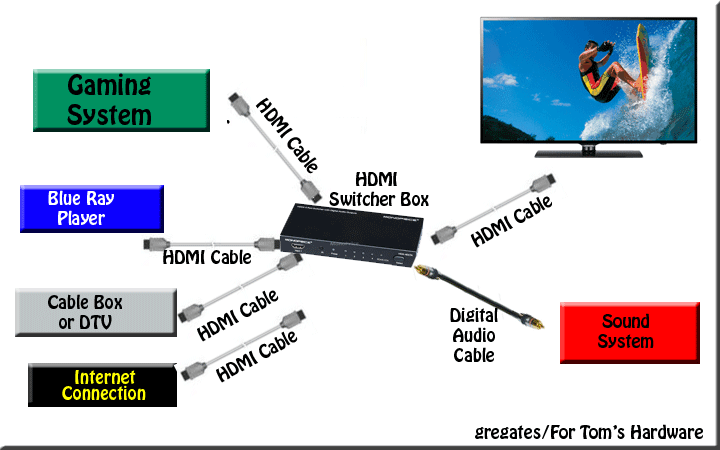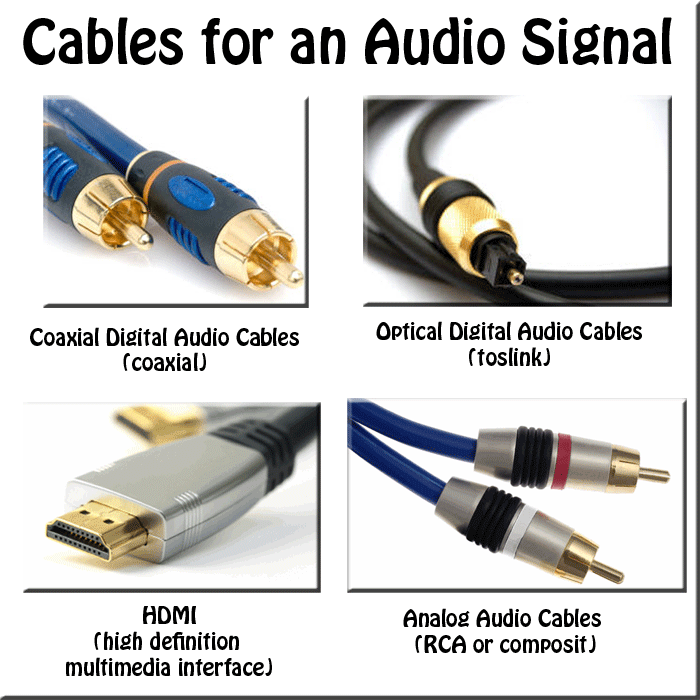Tanmoy tanmoy9991
In looking at your TV on line, it appears to NOT have an "Audio out" function. (i.e. a method to connect directly from the TV into the home theater system). If that IS the case, the following should work.
I have a brand new 55" Samsung with
ZERO audio outputs (go figure). My 55" Samsung is a model UN55FH6003F
To solve the problem of improving the sound quality versus listening to the original on-board internal Samsung TV speakers, I bought an HDMI switcher box that has three "separate" audio outputs as well as an HDMI output and 4 HDMI inputs..
So I have
three HDMI inputs plugged currently "into" the new HDMI switcher box:
(1) HDMI from my cable box
(2) HDMI from my dvd
(3) HDMI from a "Smart" TV internet box (my TV is not a "smart TV" so this box lets me connect my TV to the Internet)
Then
"from" the HDMI switcher box
(1) one
HDMI output to my new TV for the TV video
(2) one separate
audio Digital output for TV sound
The switcher box I am using, gives you choices of three different types/choices of separate audio outputs to plug into your sound system/sound bar/amplifier/surround sound/BOSE Solo:
(a) digital coax audio (recommend if under 10 to 15 feet cable length)
(b) digital optical audio
(c) older analog red/white RCA audio
So I have my audio going from the new HDMI switcher box to a separate audio system (could be any receiver/external speakers/home theater/surround sound/whatever).
For sound, I personally hook into a BOSE Solo system using the Digital COAX audio cable. I chose the BOSE unit because I wanted to control our sound volume with a remote. I just turn off or lower the original TV's crummy speakers only using the BOSE for sound. But ANY separate sound system can be hooked in (a separate Amp/sound bar, whatever). This worked perfectly for setting up my Home Theater.
The HDMI switcher box I am using is a
Monoprice 5557 pretty cool and not expensive.
Just go to their web site and search for "
5557".
http /www.monoprice.com/Product?c_id=101&cp_id=10110&cs_id=1011002&p_id=5557&seq=1&format=2
GAMERS you will like this!
/www.monoprice.com/Product?c_id=101&cp_id=10110&cs_id=1011002&p_id=5557&seq=1&format=2
GAMERS you will like this!
There also is a 4th (forth) separate HDMI input on the front of the HDMI switcher box unit, that my son uses for his XBox (or you can hook up to any other gaming system). You may need an HDMI adapter/converter for some gaming systems. Our XBox HAS an HDMI "out" function. Adapter/converters are out there. Just found one for a gamer for their Wii.
Your Audio Signal Cable Choices
Digital versus Analog
Digital audio cables are meant to transmit a sophisticated high definition audio signal between your audio source component and a component to "play" the sound into your room. The older analog audio cables did the same thing, but they use TWO wires and the sound is nowhere close to as sophisticated. If you spent money to purchase a high definition component to "play" your sound, if at all possible, you want to use one of the three "digital" cabling choices.
The playing component referred to, could be your stereo speakers, a surround sound system, a home theater amplifier, a sound bar etc,. In short, a more sophisticated sound source to "play" your sound, than just simply using the speakers housed inside your TV.
Coaxial Digital Audio Cables or SPDIF SPDIF stands for "Sony/Philips Digital Interface Format". Coaxial digital audio cables have a good "tight" fit to your source sound component and your playing component. Sources say that over distance there is a loss of signal quality. Consult your cable source as to what they say for signal quality versus the length of cable distance. Some sources advertise longer cables constructed for longer distance with no or minimal signal quality loss. If you are less than 15 feet, don't give it a a second of thought, you are fine!!!
Optical Digital Audio Cables or Toslink Toslink stands for "Toshiba Link". Optical digital audio cables transmit your sophisticated digital audio signal just like Coaxial (above), but can do it over much greater distances than Coaxial, without having to boost the signal. So if your components are 20 feet apart, use Optical. But, there are limitations. Optical cables use light to transmit the signal. So if you have tight bends in your path from one component to the other, Optical might not be the answer.
Analog Audio Cables Analog audio cables, commonly known as RCA, stereo, or composite audio cables. Prior to the high definition and digital world, we all used these for hooking up our stereo components. Basically color coded one red and one white for a two channel "left" and "right" audio connection (if there is a "third" cable for an analog video signal, it is usually color coded yellow).
High Definition Multimedia Interface Cables Referred to commonly as HDMI cables, this is always your best choice. Remember, the three other choices presented here, ONLY transmit your AUDIO signal from component to component. There ALWAYS has to be a third cable transmitting the VIDEO signal component to component with the other three choices. Example, if you use a Coaxial Digital Audio Cable from your DVD to your high definition TV, you STILL need to run a separate video cable from the DVD to the TV as well. BUT running an HDMI cable from your DVD to the TV transmits a digital signal of BOTH video and audio. You use one cable instead of two. Both the video and the audio signals are digital.
Why I had to use the HDMI switcher box
In my case, I needed to send two SEPARATE signals from my source components (cable box, DVD, Xbox) to [1] first a video from my source component to the TV and [2] second an audio signal from my source component to my separate sound system (in my case my BOSE Solo).
Bottom-line, IF your TV HAS an "Audio Out" plug for any of the above audio cables, use that to go to your separate audio component. Otherwise, my solution detailed above works absolutely great.
Remember IF your TV HAS an "Audio out" function, just use that to connect to your home theater.
Enjoy!


 /www.monoprice.com/Product?c_id=101&cp_id=10110&cs_id=1011002&p_id=5557&seq=1&format=2
/www.monoprice.com/Product?c_id=101&cp_id=10110&cs_id=1011002&p_id=5557&seq=1&format=2

